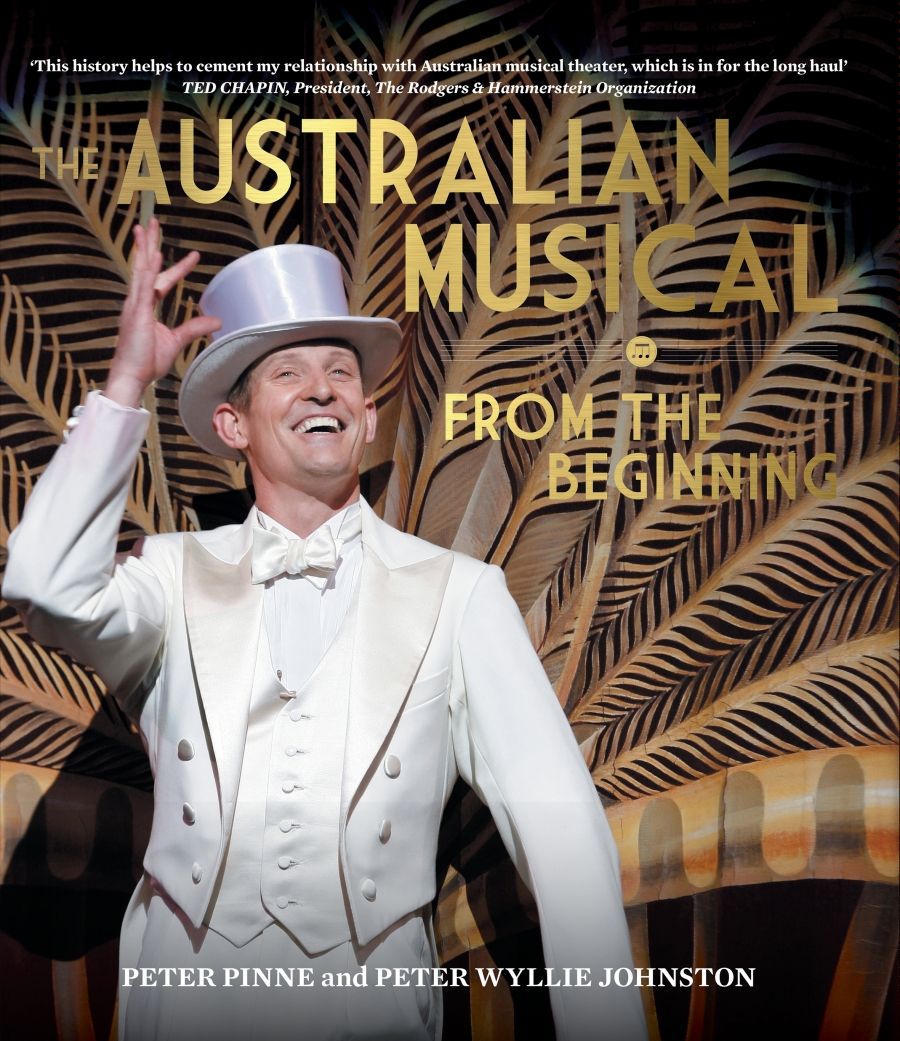
- Free Article: No
- Contents Category: Theatre
- Review Article: Yes
- Custom Highlight Text:
What is the musical’s appeal? Performing arts venues in Australia’s capital cities stage them year after year; a lucrative box office seems to be virtually guaranteed. The feel-good mix of song, melodrama, and vibrant dance – not forgetting the bonus of a happy ending – can lift the spirits and entertain the entire family. Recently, Chicago (Melbourne, Brisbane), West Side Story, and Billy Elliot (Adelaide) secured packed houses.
- Grid Image (300px * 250px):

- Book 1 Title: The Australian Musical from the Beginning
- Book 1 Biblio: Allen & Unwin, $79.99 hb, 432 pp
The Australian Musical from the Beginning is a charming and superbly illustrated volume. Lovingly and meticulously researched, it is crammed with intriguing cameos, insightful detail, and sorry tales of artistic misadventure. Authors Peter Pinne and Peter Wyllie Johnston are industry veterans. Johnston is director of the Australian Music Theatre Research Institute, and the composer and lyricist of Tamarama. Pinne and Don Battye have written seventeen musicals. In 1995, Pinne and Battye’s Prisoner Cell Block H: The Musical, based on the television series Prisoner, opened at the Queen’s Theatre, London, to much acclaim.
Post-Federation Australia, as the authors remind us, remained ideologically and sentimentally connected to Britain and was in the thrall of American culture. The entrepreneur J.C. Williamson exploited this mindset. Through his eponymous company he ensured the musical’s popularity by importing much-loved American and British shows. He produced only two Australian musicals. Some creatives – notably Jack Fewster, known as Australia’s Irving Berlin – longed to produce Aussie shows every bit as fêted as their overseas equivalents.
Slowly, the gathering national pride unleashed a desire for home-grown product. Among the first crop of quintessential Aussie shows were those created by women such as May Brahe, Ella Airlie, Edith Aird, Varney Monk, and Dot Mendoza. Nonetheless, their substantial contributions are largely unknown. Today, women are once again ardent contributors to the form. In Tasmania, Fran Armstrong’s Aussie Rules: The Musical met with acclaim. In her wake came composer, lyricist, and performer Joanna Weinberg, Megan Shorey, Fiona Thorn, and Carolyn Burns. Kate Miller-Heidke’s Muriel’s Wedding, with music and lyrics co-written with Keir Nuttall, was lauded when it opened in Sydney in 2018.
 The cast of Muriel's Wedding: The Musical (Sydney Theatre Company/Global Creatures)
The cast of Muriel's Wedding: The Musical (Sydney Theatre Company/Global Creatures)
The ambition to create a seminal Australian musical was not for the faint-hearted, and it attracted larger-than-life characters. Brahe first made her name as a songwriter. Considering the local market for her songs too meagre, the then twenty-three-year-old abandoned her husband and young children and went to London, promising that she would return when she had earned enough money.
Brahe’s contemporary Oscar Asche lived in a cave near Jervis Bay and mused on whether he should become an actor. After breakfasting on eggs and oysters, he would recite Shakespeare on the beach and imagine that the waves crashing onto the shore were thunderous applause. In 1916, Asche created the book and lyrics for Chu Chin Chow and commissioned English composer Frederic Norton to write the music. It opened in August 2016 at His Majesty’s Theatre, London. Five years later, it had chalked up 2,238 performances and was the longest-running show in the world. Its popularity was eventually surpassed by Rodgers and Hammerstein’s Show Boat.
The lack of philanthropy and government grants, and the reluctance of producers to fund the home-grown, were continual thorns in the side of creative enthusiasts. Clement John De Garis wrote the score, music, and lyrics for F.F.F., which was produced by Hugh D. McIntosh, who persuaded De Garis to invest his own capital in his oddly named show. It ran at a loss and De Garis found himself in debt to the tune of £420,000 before his suicide in 1926.
If the drive towards Australian content in musicals was slow, there was an even longer wait for First Nations people to be reflected in storylines, let alone to power an entire musical. In Monk’s Collits’ Inn, a tokenistic corroboree enacted on stage was a notable standout in Frank Thring’s production. Fewster’s Yantabinjie, the tale of a theatrical troupe stranded on an outback cattle station, featured an Aboriginal cook and his wife.
Fast forward to 1990, and composer– lyricist Jimmy Chi’s trailblazing Bran Nue Dae, which premièred in Perth. It was risqué and tongue-in-cheek; at the end of one song the audience was showered with condoms from the set’s ‘Condom Tree’. Bran Nue Dae, the first Aboriginal musical, was adapted into a major feature film starring Ernie Dingo, Geoffrey Rush, Missy Higgins, Jessica Mauboy, and Deborah Mailman. The film earned $7.5 million at the box office and inspired The Sunshine Club by Wesley Enoch and John Rogers, and the gritty Corrugation Road.
This is the first comprehensive and scholarly consideration of the musical in Australia. It surveys the genre’s poignant, triumphant, and frustrating climb towards global and national recognition. The A–Z features snapshots of three hundred Australian musicals selected from a possible seven hundred. The inclusion of these musicals’ most significant songs unveils a rich seam of previously neglected repertoire. The Australian Musical from the Beginning is not only a pleasurable read; as a catalogue of musicals, it will no doubt become a valuable resource and a catalyst for staging revivals of these forgotten works.


Comments powered by CComment